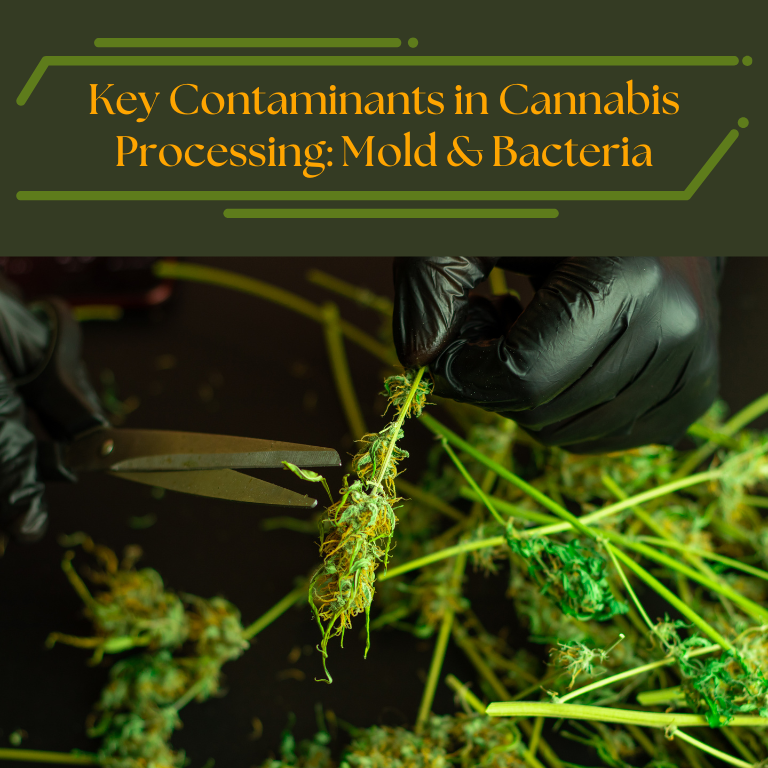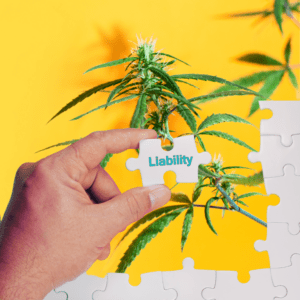Key Contaminants in Cannabis Processing: Mold & Bacteria

The growing legalization and popularity of cannabis have spurred demand for higher-quality products, making safety a primary concern. Like any agricultural product, cannabis can be vulnerable to contaminants—primarily mold and bacteria. These contaminants pose health risks and can impact product quality and regulatory compliance. This article explores key contaminants, specifically mold and bacteria, examining their origins, risks, and strategies for mitigation in cannabis processing.
Understanding Contamination Risks in Cannabis
Cannabis contamination can originate from multiple sources, including the environment, handling practices, and storage conditions. Key contaminants like mold and bacteria can thrive at various stages, from cultivation to processing and packaging. Ensuring a high standard of hygiene and quality control at each stage is crucial to reducing contamination and safeguarding consumer health.
Why Are Mold and Bacteria Common in Cannabis?
The cannabis plant is susceptible to environmental and microbial contaminants due to its natural biology and cultivation environment. Cannabis plants grow best in warm, humid conditions—ideal for the growth of microorganisms like mold and bacteria. As the cannabis industry grows, consistent testing and quality assurance have become essential to preventing contaminants from reaching consumers.
Mold in Cannabis Processing: Identifying and Managing Risks
Mold is one of the most common contaminants in cannabis, and it can develop during the cultivation, drying, or storage stages. The presence of mold can compromise product quality and even lead to serious health risks, especially for immunocompromised individuals.
Common Types of Mold in Cannabis
Aspergillus: Known for causing respiratory infections, Aspergillus can be dangerous for consumers, particularly those with weakened immune systems. It is a resilient mold that can develop in various environments, including cannabis.
Botrytis cinerea (Gray Mold): This type of mold causes gray mold disease, often affecting cannabis plants during humid conditions. If not properly controlled, it can spread rapidly and destroy the plant.
Penicillium and Cladosporium: These molds are also frequently found on cannabis and can produce mycotoxins, harmful compounds that pose significant health risks when inhaled or ingested.
Health Risks of Mold in Cannabis
Inhaling or ingesting mold-contaminated cannabis can lead to various health issues, including respiratory problems, allergic reactions, and, in severe cases, infections. Individuals with compromised immune systems, asthma, or allergies are particularly at risk. Mycotoxins produced by certain molds, like aflatoxins from Aspergillus, can be carcinogenic and increase the likelihood of long-term health complications.
Causes of Mold Growth in Cannabis
Several factors contribute to mold growth on cannabis plants and products:
Humidity and Temperature: Cannabis plants are prone to mold when exposed to high humidity and warm temperatures, as these conditions create an ideal environment for microbial growth.
Improper Drying and Curing: Insufficient drying and curing allow moisture to remain within cannabis buds, fostering mold growth. Proper curing reduces moisture content to levels that prevent mold formation.
Poor Storage Conditions: Cannabis should be stored in dry, cool environments with controlled humidity levels. Storing cannabis in damp or overly humid conditions can quickly lead to mold development.
Preventing Mold Contamination in Cannabis Processing
The best defense against mold contamination is prevention. Here are key steps to minimize the risk:
Environmental Controls: Maintaining an optimal environment with low humidity (30-50%) and moderate temperatures (60-70°F) can significantly reduce mold risk during both cultivation and storage.
Proper Curing Techniques: Cannabis curing is crucial for mold prevention. Thoroughly drying the product and storing it at the right humidity level can prevent mold growth during packaging and storage.
Regular Mold Testing: Regular testing is essential to identify mold contamination early in the processing stages. Lab testing helps ensure that cannabis products meet safety standards before they reach consumers.
Bacteria in Cannabis Processing: Common Types and Risks
Bacteria are another frequent contaminant in cannabis products, with certain strains posing health risks to consumers. Bacterial contamination is often harder to detect than mold because it may not produce visible signs on the plant. However, bacterial infections can occur if cannabis plants are exposed to unsanitary conditions or improper handling.
Types of Harmful Bacteria Found in Cannabis
Salmonella: A common foodborne pathogen, Salmonella can cause severe gastrointestinal illness and is especially dangerous in immunocompromised individuals.
Escherichia coli (E. coli): Found in soil and water, E. coli contamination is often linked to unclean growing conditions. Some strains, like E. coli O157
, can cause severe food poisoning symptoms.
Pseudomonas: This bacterium can cause respiratory issues and is sometimes found on plants in humid environments.
Health Risks Associated with Bacterial Contamination in Cannabis
Bacteria like Salmonella and E. coli can cause symptoms ranging from mild gastrointestinal discomfort to severe illness, including vomiting, diarrhea, and abdominal pain. Contaminated cannabis products consumed through inhalation or ingestion can carry these pathogens directly into the body, increasing the risk of infection. Bacterial contamination is particularly concerning for medical cannabis users who may already have weakened immune systems.
Factors Contributing to Bacterial Contamination
Bacterial contamination in cannabis can result from several factors, including:
Unclean Growing Conditions: Soil, water, and air quality directly impact bacterial levels in cannabis plants. If these environmental factors are contaminated, bacteria can transfer onto the plant.
Poor Hygiene in Processing Facilities: Unsanitary practices during harvesting, trimming, and packaging increase the risk of bacterial contamination.
Cross-Contamination During Processing: Handling cannabis alongside other materials can lead to cross-contamination, especially if proper sanitation practices are not followed.
Reducing Bacterial Contamination in Cannabis Processing
Effective sanitation and quality control protocols are essential for reducing bacterial contamination in cannabis products:
Sanitization Practices: Regular sanitization of tools, surfaces, and equipment in cultivation and processing facilities helps reduce bacterial spread.
Water Quality Monitoring: Using clean, tested water can prevent bacteria from entering the growing environment, reducing the risk of bacterial contamination.
Employee Hygiene Protocols: Workers should follow strict hygiene practices, including using gloves and washing hands frequently, to prevent the transfer of bacteria to cannabis products.
Testing Protocols: Ensuring Safety in Cannabis Products
Both mold and bacteria can be effectively controlled through rigorous testing protocols. Testing not only ensures that products meet safety standards but also allows producers to identify and address contamination issues early.
Importance of Third-Party Testing Labs
Third-party testing provides an unbiased assessment of cannabis quality, detecting mold, bacteria, pesticides, and other contaminants. Many state regulations require cannabis companies to undergo third-party testing to certify that products are safe for consumer use. Independent labs test for the presence of harmful microorganisms and check compliance with legal standards, ensuring products are both effective and safe.
Types of Tests for Mold and Bacteria
Common tests for detecting contaminants include:
PCR Testing (Polymerase Chain Reaction): PCR tests can detect specific bacterial or fungal DNA, providing accurate results quickly. It is widely used to detect molds like Aspergillus.
Colony-Forming Unit (CFU) Testing: This method determines the number of viable bacteria in a sample, helping to assess contamination levels.
Mycotoxin Testing: Mycotoxins are toxic compounds produced by molds. Testing for mycotoxins ensures that cannabis products do not contain harmful levels of these substances.
Best Practices for Mold and Bacteria Control in Cannabis Processing
Cannabis processing facilities must adopt best practices to prevent mold and bacterial contamination. Implementing these strategies can ensure product safety and maintain quality:
Maintain Environmental Controls: Keeping humidity and temperature within ideal ranges helps reduce the likelihood of mold and bacteria growth.
Implement Standard Operating Procedures (SOPs): SOPs for sanitization, storage, and employee hygiene create consistent practices that minimize contamination risks.
Invest in Quality Control Technology: Technology, such as automated environmental control systems, can continuously monitor and adjust humidity, temperature, and airflow to create an optimal environment.
Conduct Regular Training for Employees: Workers should be trained in identifying contamination signs and understanding the importance of hygiene and safe handling practices.
Ensure Comprehensive Documentation: Keeping records of all cleaning, testing, and environmental control procedures helps maintain accountability and can be useful during regulatory inspections.
The Importance of Vigilance in Cannabis Processing
As the cannabis industry continues to evolve, consumer demand for safe, high-quality products will only increase. Staying vigilant about mold and bacterial contamination is essential for maintaining industry standards, ensuring compliance, and protecting public health. Whether through environmental controls, regular testing, or sanitation protocols, preventing mold and bacterial contamination should be a top priority for all cannabis producers.
In an industry where consumer trust is paramount, implementing best practices and adhering to regulatory standards is critical. By staying proactive about contamination prevention, cannabis processors can ensure that their products meet safety requirements and deliver a safe experience for all consumers.











